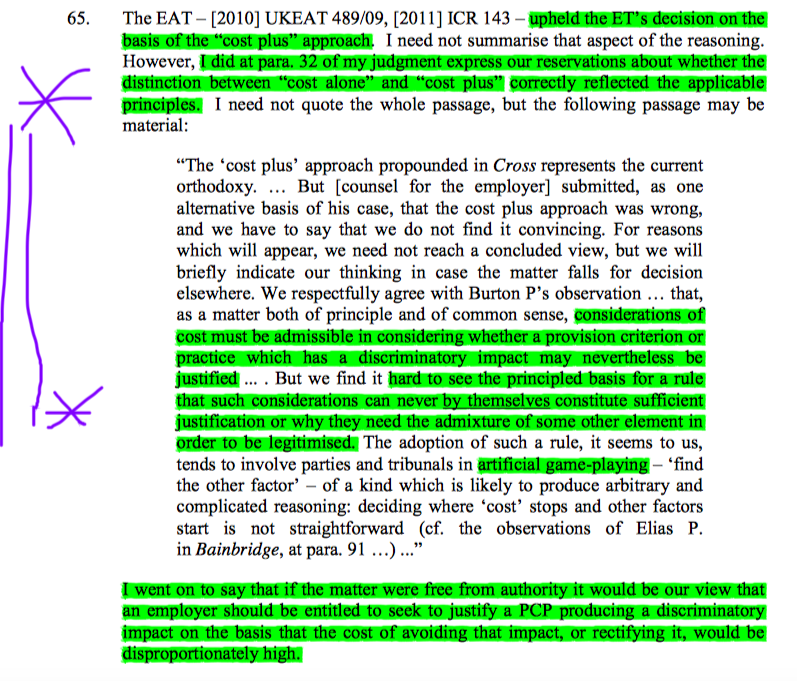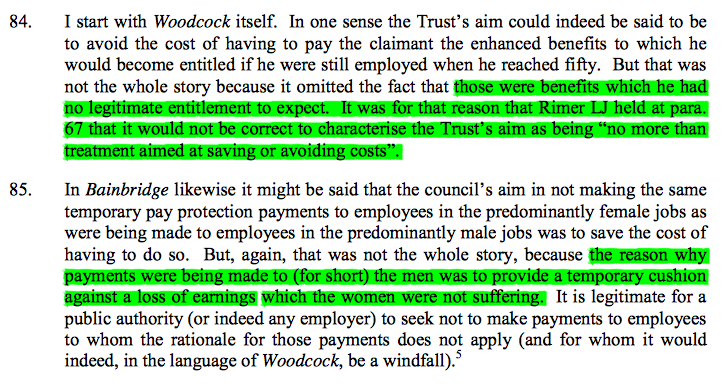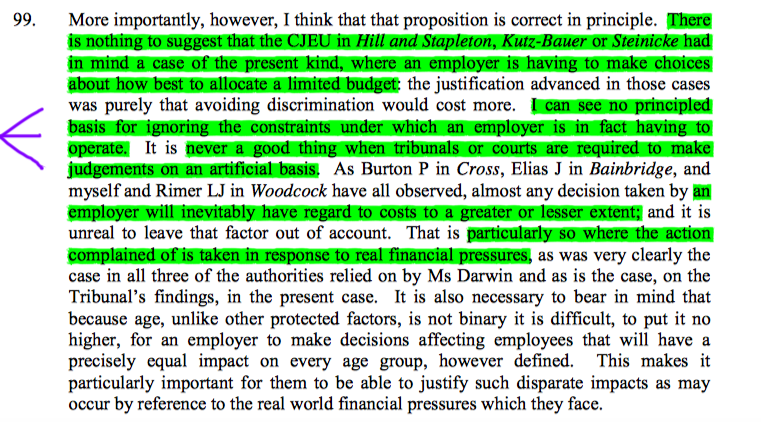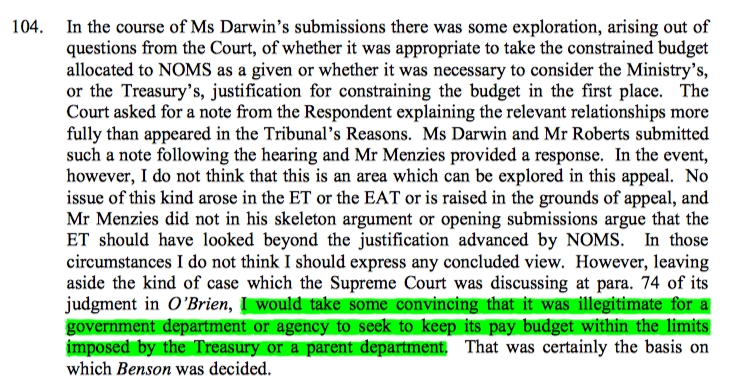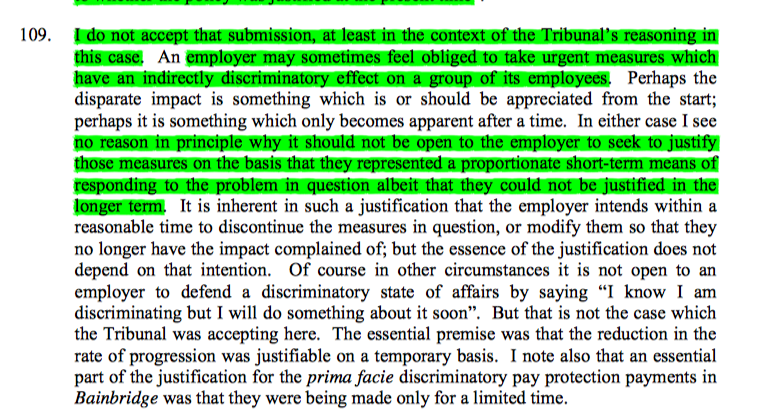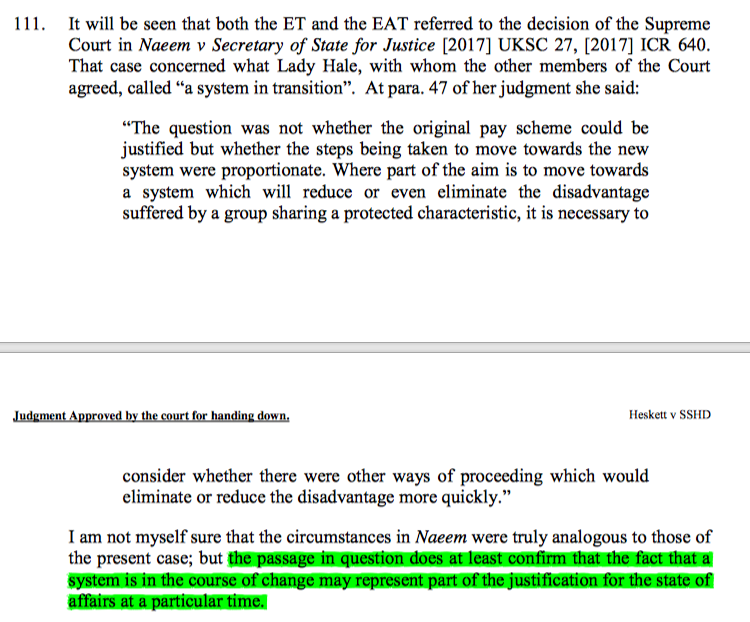1/ In Heskett v MoJ, the CA held that living within budgetary restraints can be a legitimate aim & doesn't fall foul of any prohibition on justifying prima facie indirect discrimination on a 'solely costs' basis: https://www.bailii.org/ew/cases/EWCA/Civ/2020/1487.pdf #ukemplaw
2/ Mr Heskett works for the probation service under the MoJ. The pay progression was the traditional public sector set-up with spinal points within a pay band. Pre-2010 it would take around 8-9 years to get from bottom to top of the band H was in, at 3 spinal points a year.
3/ Then George Osborne's austerity hit & the public sector pay freeze occurred. Budgets were cut & public sector services had to tighten their belts. The probation service did so by slowing down spinal point progression. It would now take 3 times as long to climb the spinal scale
4/ Those at the top of the scale had nowhere left to go, whilst those lower down were climbing at a snail's pace and had to look far into the future before they'd be earning the riches (comparatively) of their top of their colleagues at the top of the ladder.
5/ Inevitably, this meant that younger probation officers were hit the hardest overall. Elder officers were more likely to be more experienced & hence more likely to have found their way to the top of the ladder. An indirect age discrimination claim was brought.
6/ Prima facie indirect discrimination was pretty much accepted before the ET. The real battle was on justification. The ET identified the PCP as implementation of a pay policy which included pay progression by length of service, reduced from 3 spinal points per year to 1.
7/ The ET found living within its means to be a legitimate aim, & distinguished that from a 'solely costs' aim, holding it to come from an absence of means. The ET held the PCP was justified given the employer's treatment of it as a stop-gap & efforts/intention to improve on it.
8/ The EAT upheld the ET's decision. The appeal to the CA was on 3 grounds, the main one of which was whether the ET had erred in distinguishing (i) absence from means from (ii) costs as a legitimate aim.
9/ To answer that question, Underhill LJ took a lengthy but fascinating excursion through domestic & European case law, taking in such famous cases as Unison, O'Brien, Schonheit & Bainbridge, as well of course as Cross & Woodcock.
10/ My favourite of the cases he looked at, however, was the first one, simply because to Yiddish speakers the instant reaction to the name will be to wonder who sneezed:
11/ It will come as no surprise to students of Underhill's judgment in Woodcock in the EAT that he reached a narrow conclusion about the preclusion of a 'solely costs' based legitimate aim.
12/ Agreeing with Rimer LJ's judgment in Woodcock, Underhill LJ held that saving or avoiding cost could not, without more, amount to a legitimate aim. The fundamental question was whether the aim was no more than a wish to save costs. If it was, justification failed.
13/ That approach allows for a common sense, expansive approach to whether the costs+ test was satisfied, as shown by Underhill LJ's analysis of Woodcock and Bainbridge in that light.
14/ In reaching his conclusion, Underhill LJ expressed a preference for eschewing the 'costs plus' & 'costs alone' verbiage, preferring a focus on how the employer's aim could be fairly characterised rather than an overly mechanistic search for the added factor.
15/ With that focus in mind, it should come as little surprise that Underhill LJ was satisfied as to the legitimacy of living within the employer's means - ignoring the real-life constraints within which the employer operated would be artificial & that's 'never a good thing'
16/ In particular, Underhill LJ considered he would take 'some convincing' before he could be persuaded it was illegitimate for a government department to keep to the budget imposed by the Treasury.
That must be right as a common sense conclusion.
That must be right as a common sense conclusion.
17/ That of course leaves the question of proportionate means as the real battle to be fought in such cases. The important point in Heskett was the CA's acceptance that it can be relevant to proportionality that a measure is intended to be a temporary stop-gap.
18/ As Underhill LJ put it, it should be open to an employer to argue that something is proportionate as a temporary response whilst recognising it wouldn't be proportionate in the long term. That is consistent with the consideration in Naeem of the transitory situation.
19/ However, as the ET had itself recognised in this case, the longer a stop-gap remains in place, the harder it might become to justify.
That analysis will clearly be dependent on the facts of the individual case, but the employer would be wise to keep under review at least.
That analysis will clearly be dependent on the facts of the individual case, but the employer would be wise to keep under review at least.
20/ So there we go. A useful rowing back from the power of a claimant's reliance on the costs plus principle, and some useful guidance on proportionality of stop-gap measures.
21/ And finally, a well done (if he secretly reads this thread) to my ex-roommate and mentor EJ Crosfill in (a) being upheld, & (b) providing the opportunity for Underhill LJ to finish the clarification task he started 10 years ago as Underhill J in Woodcock. #ukemplaw

 Read on Twitter
Read on Twitter


